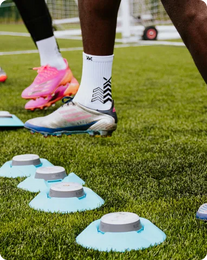The T-Test is an agility test used for assessing the multidirectional movement efficiency of athletes.
The test is simple to administer and does not need any special equipment. Because of its simplicity and efficacy, it is widely used in evaluating players for sports such as field hockey, lacrosse, basketball, handball, and soccer.
As a drawback, only one person can perform the test at a time. For multiple people, multiple test setups and timers are needed, an issue solved by Blazepod.
What Does the T-Test Check?
As the name implies, the T-Test for agility checks how quickly and efficiently someone can move around. This test aims to assess the lateral movement, change of direction, agility, speed, cutting crossover, shuffling efficiency, and acceleration of athletes.
The Procedure
Two cones, A and B, are placed 10 meters apart. Two more cones, C and D, are placed 5 meters away on both sides of cone B to form a T-shape. Due to the distances between the cones, the T-Test is also known as the 5-10-5 agility test.
The steps involved in the test include:
- The participant takes position at cone A.
- When the tester gives the command, the participant runs forward to cone B and touches the base of the cone with their right hand.
- Next, the participant has to turn left and shuffle sideways to cone D. They need to touch the base of this cone but with their left hand this time.
- Once there, the participant must shuffle to cone C and touch the base with their right hand.
- Next, the participant shuffles back to cone B and touches its base with their left hand.
- The test concludes with the participant running backward to cone A.
- Stop the stopwatch once they cross cone A.
Prerequisites and Caution
The T-test might look simple, but some things need to be taken care of before the test is conducted. These are imperative for the safe completion of the test and a fair evaluation of the participant's performance. These include:
- The participant is briefed about the test before it starts.
- A spotter is stationed behind cone A to catch the participant if they fall while running backward.
- The surface where the test takes place needs to be consistent and free of anything that can cause the participant to fall.
- One timer should only monitor one subject during the test for reliable evaluation.
How Are the Scores Calculated?
There are some conditions that the subject needs to fulfill during the trial. Like the Illinois agility test and shuttle run test, the test will not be valid if the participant does not follow the rules. These rules include:
- The subject must keep facing forward throughout the duration of the test.
- Crossing one foot in front of the other is not allowed.
- Failing to touch the base of any of the cones will void the test.
- Touching any cone with their feet will void the test.
As per the above rules, three qualifying trials are conducted, and the best time of three consecutive attempts is the participant's score.
Acceptable Scores for the Test
Acceptable scores for the test vary from situation to situation as different sports might need players to complete the test in different amounts of time.
Generally, the following is how the subjects are qualified:
|
Males (Seconds) |
Females (Seconds) |
|
|
Excellent |
Less than 9.5 |
Less than 10.5 |
|
Good |
9.5 to 10.5 |
10.5 to 11.5 |
|
Average |
10.5 to 11.5 |
11.5 to 12.5 |
|
Poor |
More than 11.5 |
More than 12.5 |
The T-Test might appear to measure how fast an individual can move and change direction, but, according to research, it also tells a lot about an individual's physique.
What Does the Research Say About the Agility T-Test?
According to a study titled "Reliability and Validity of the T-Test as a Measure of Agility, Leg Power, and Leg Speed in College-Aged Men and Women," in addition to testing the ability of an individual to move in all directions as fast as possible, the T-Test also tests the "combination of leg speed, leg power, and agility for performance."
Individuals who perform excellently in the test show that they can coordinate lower limb strength, power, and speed while changing directions at a fast pace.
As leg power and strength are vital in reducing injuries in sports, the T-test provides an excellent way to evaluate people before they enter professional sports.
What is Needed to Ace the Test?
Leg Speed, leg power, and agility are the three things needed to ace the T-Test. Luckily for anyone taking this test, all of these are present to a reasonable extent. Participants can also train and condition themselves to improve these traits and perform better at the test.
How to Prepare for the T-Test?
The preparation for the T-Test includes drills that increase agility. The key to succeeding in the test is to note the areas where the players lack and improve on them.
Agility drills using Blazepod can help prepare for the test because you can:
- Measure the ability to accelerate and slow down in all directions.
- Test the change of direction time as well as stop and go speed.
- Digitally record the performance of the athletes.
- Generate live data to analyze the performance.
- Closely monitor and analyze each movement of the test and recognize where improvement is needed.
- See the roundup of the results throughout all the trials.
- Set attainable benchmarks to improve specific areas, compare results across trials, and track progress and improvement.
Training Drills for T-Test Using Blazepods
You can modify drills with blazepods to improve the agility of your athletes. Here are some ideas that can help.
T-Test Agility Drill
The simplest way to prepare athletes for the T-test is to use the setup of the T-test itself. However, to get a clearer picture of an athlete's performance, place a blazepod at the base of all four cones.
Conduct the test as stated above but have the athlete tap the pods instead of touching the base of the cones. By doing so, you will have a better idea of whether the athlete is lacking in running forward, shuffling, or running backward speed. You can then work on that specific area to improve the results.
To make the test even more challenging for the participants:
- Have them perform the drill blindfolded.
- Decrease the distance between the cones so that the athletes have to change direction more often and abruptly.
- Set a time limit and ask the athletes to complete the drill within that time.
Box Agility Drill
The Box Agility Drill is designed to improve participants' agility and direction-changing efficiency but with a factor of uncertainty in it.
Drill Setup
- Place four blazepods 5 meters away from each other to form a square.
- Position the participant at one of the pods. Name it Pod 1.
- Name the other pods 2, 3, and 4.
Drill Execution
- Shout commands at the athlete while they execute them.
- Keep the following command a surprise for the player. For example, start with "run to pod 3," Once they tap pod 3, say, "shuffle left to pod 4."
- Do the drill for 10 minutes.
- Let the participant rest for one minute before doing another 10 minutes of the drill.
Dot Drill for Agility
Since the T-Test for Agility primarily assesses the strength of the legs, this T-Test exercise focuses on improving the power of the legs and the coordination of the body. It also enhances stability as well as knee and ankle strength.
Drill Setup
- Draw a pattern of dots on the ground like the 5 in a dice.
- The two dots on one side need to be as wide as the participant can spread their feet apart.
Drill 1
- Start the drill with the participant standing with their feet at the dots on one side of the square.
- When the signal is given, the participant jumps onto the center dot with both their feet landing together and then on to the dots on the other end of the square with one foot at each of the dots.
- The participant then jumps back onto the center dot and then back to the starting dots.
- Have the participant complete three sets of six reps each.
Drill 2
- The participant should go forward in the same way as in drill 1.
- At the far end of the square, the participant needs to spin 180o and jump forward to the starting position.
- Have the participant perform three sets of six reps each.
Drill 3
- Position the participant with one foot at each of the dots on one side of the square.
- The participant needs to move their right foot to the center dot and left foot to the forward dot,
- Next, the right foot to the forward dot and left foot to the center dot
- Lastly, the right foot back to the starting dot, and the left foot back to the starting dot.
- Ask the participant to keep increasing the speed with each rep and complete three sets of six reps each.
Other Agility Tests
Besides T-Test, other commonly used agility tests include:
- Hexagon Agility Test
- Illinois Agility Test
- Shuttle Run Test
- Modified T-Test
Of these, the modified agility T-Test or MAT is the most frequently used.
How to Do a Modified T-Test for Agility?
The methodology of MAT is the same as the standard T-Test but with a bit of change to the dimensions of the "T."
If you refer to the image describing the T-Test at the start of the article, the differences are:
- The distance between cones A and B is 5 meters.
- The cones C and D are both 2.5 meters away from cone B.
The execution of the test and all other rules are the same.
In Conclusion
The T-Test is a simple yet effective way of assessing the agility of athletes. It consists of running forward, shuffling sideways, and running backward on a set path. This test tests how fast a person can move and change directions and the strength and stability of his legs, ankles, and knees. As mentioned previously in the article, to make the test even more challenging and ensure success, use Blazepod. Learn more here >
Frequently Asked Questions
What are good agility t-test results?
A good result for the agility t-test is under 9.5 seconds to complete one trial for men and under 10.5 seconds for women.
How to decrease T-Test time agility?
The key to decreasing T-Test time is practice. Improving forward and backward movement, as well as sideways shuffling, will result in better scores. You can set up cones at home in the shape of the T to practice and improve the time it takes you to complete the test.
What is the objective of the T-Test for agility?
The T-Test for agility aims to measure the speed of movement, change of direction, and the strength and stability of the legs, knees, and ankles of the subject. This pro agility test is used to evaluate players for various professional sports and some armed forces recruitments.
What does the T-Test agility measure?
The T-Test agility measures the time it takes the subjects to run forward from one cone to another 10 meters away, then to the next one five meters to the right, finally to the next five meters to the left, and finally back to the starting cone.




















